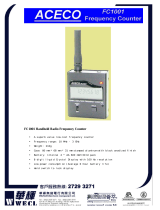
User Manual for PCF85x3, PCF85x63, PCA8565, PCF2123, and
PCA21125
All information provided in this document is subject to legal disclaimers.
© NXP Semiconductors N.V. 2015. All rights reserved.
8. Capacitors and capacitor selection
The influence of temperature on the accuracy of the RTC application due to the
temperature coefficient of the capacitances C
IN
and C
OUT
is far less than due to the
temperature coefficient of the crystal. Nevertheless it is good to be aware of some
differences between the various types of capacitors (dielectric) around.
Ceramic capacitors tend to have low inductance because of their flat plate construction.
Most other types of capacitor are wound and thus inductive. Nowadays SMD capacitors
are dominant in small signal applications.
The EIA (Electronic Industries Alliance) has issued EIA-535 which defines capacitor
dielectric classes. Class I and Class II dielectrics have been defined. Within these
classes several types of dielectric exist. The most common ceramic types are C0G/NP0,
X7R, Y5V and Z5U but others exist too.
C0G (EIA) or NP0 is the highest quality of these with the lowest capacitance /
temperature dependence (Negative-Positive Zero), but has a lower permittivity, which
means that its capacitance range is more restricted. NP0 refers to the shape of the
capacitor’s temperature graph and for NP0 this graph is nearly flat. It also exhibits a
negligible capacitance and dissipation factor change with voltage or frequency.
X7R is a reasonably stable high-permittivity dielectric which allows capacitance values up
to 1μF into a reasonable package. The available range is in the order from 100 pF to
22 μF in SMT, larger values are available in leaded packages. X7R formulations fall into
EIA Class II materials. X7R is the most popular of these intermediate dielectric constant
materials. Its capacitance variation as a function of temperature is within ±15 % from
-55 °C to +125 °C. This capacitance change is non-linear and therefore difficult to
express in ppm/°C since it changes over the temperature range. Capacitance for X7R
varies under the influence of electrical operating conditions such as voltage and
frequency. This rules out many applications, leaving only the general purpose
applications like coupling and decoupling. The leakage current is sufficiently low.
Y5V formulations are for general-purpose use in a limited temperature range. Available
range is from 1 nF to 22 μF in SMT, larger in leaded packages. They have a wide
capacitance change of +22 % to –82 % over the operating temperature range of –30°C
to +85°C. As an example, at 31% of the rated voltage (5 V over a 16 V capacitor) the
resulting capacitance will have reduced to a quarter of the rated value. The effective
decoupling capacitance present may thus be much less than expected. Y5V’s high
dielectric constant allows the manufacture of the highest capacitance value in a given
case size. These characteristics make Y5V ideal for decoupling applications within
limited temperature range. When specifying the values, the dependence on temperature
and applied voltage must be taken into account.
Z5U shows in comparison to the previous types a much worse performance. Its
capacitance changes by over 50 % with changes in temperature and applied voltage. Its
temperature range is only +10 °C to +85 °C. Its initial tolerance can be as high as -20 %
to +80 %. Its only redeeming feature is its high permittivity which allows high capacitance
values, typically ranging from 1 nF to 4.7 µF. Good for bypass and coupling applications.
It has low price, small size and low temperature stability.
Conclusion: For the oscillator only C0G types should be used. This will almost always
automatically be the case since the other types are usually not available in such small
values. For the decoupling of the RTC, use a capacitor with X7R dielectric. Using SMD




















